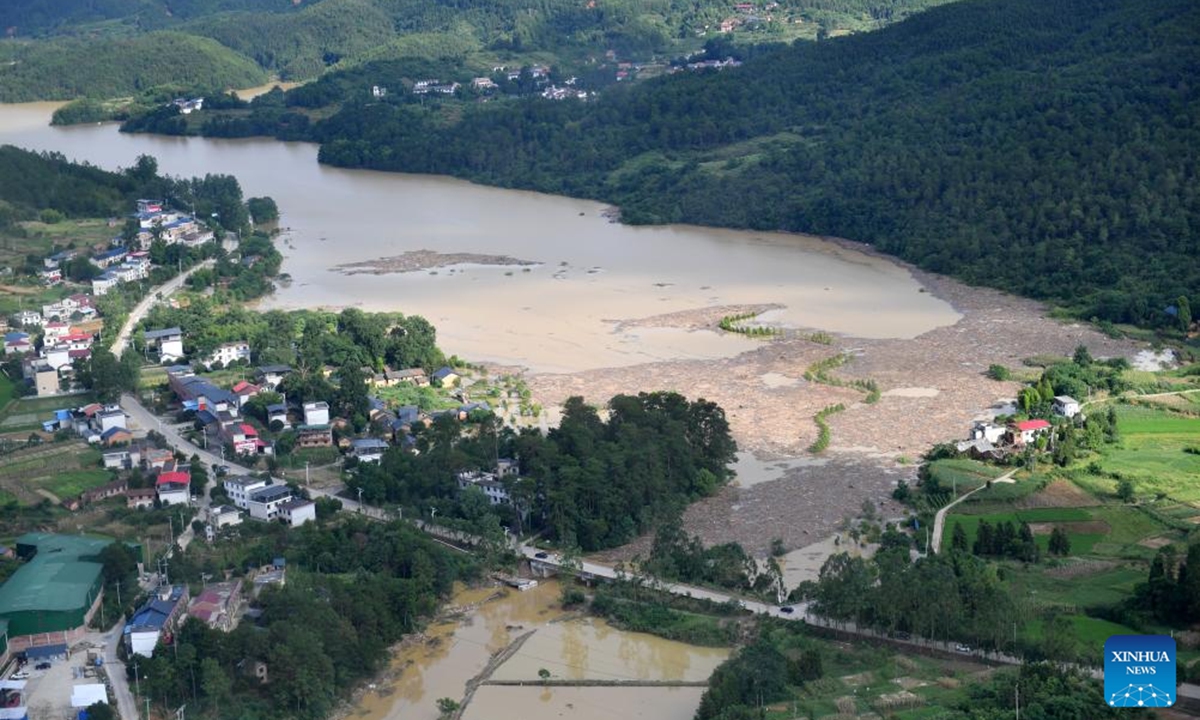
This photo taken from a helicopter on July 29, 2024 shows parts of the disaster-stricken areas in Zixing, central China's Hunan Province. A number of helicopters on Monday were sent to dispatch drinking water, rice, vegetables, medicine and other daily necessities into some disaster-stricken areas in Zixing City, and successively relocated people stranded in the waterlogged residences. (Photo: Xinhua)
Days of heavy rainfall affected by Typhoon Gaemi in Zixing city, Central China's Hunan Province has led to four deaths and three missing across four villages in Zhoumensi town and Bamianshan township. Local emergency rescue work is still ongoing.
Since July 26, Zixing has experienced extreme rainfall, with precipitation exceeding historical records. An average rainfall of 410 millimeters has been reported, the maximum precipitation is 673.6 millimeters, with the 24-hour rainfall at a single point exceeding 645.2 millimeters and the maximum hourly rainfall intensity reaching 132.2 millimeters, according to the Zixing flood control and drought relief headquarters.
The heavy rain has caused varying degrees of damage to all townships in Zixing. Some 87,200 residents have been affected by the rainfall in addition to 1,432 damaged houses, 1,345 collapsed sections of road, and 14 road closures.
Communication has been disrupted in 78 village groups in eight townships, while nine townships are experiencing power outages.
Zhoumensi town has been one of the most severely affected towns in Zixing. As floodwaters receded, local officials sent rescue teams to assist in dredging and debris transfer as well as epidemic prevention.
Following the disaster, Zixing quickly activated Level I flood control emergency response and Level III natural disaster emergency response, mobilized various forces, dispatched emergency personnel and materials to repair damaged infrastructure, distribute disaster relief supplies and minimize casualties.
Shen Xiaoming, the provincial Party secretary, who went to the disaster site on Monday, stressed the importance of restoring road access, electricity and communication networks, making road access, accelerating the repair of damaged infrastructure the top priority in emergency rescue operations.
Shen also said it is necessary to comprehensively assess the number of affected individuals, considering the wide geographical area, mountainous terrain and dispersed population across the disaster-stricken areas.
Local forces are using various methods such as real-time communication and door-to-door checks to promptly assess the situation of affected populations, and prioritize rescuing trapped individuals, treating the injured and searching for missing persons, Shen noted.
As of late Monday, Zixing has deployed 19 rescue teams, with 5,469 professional rescue personnel, four helicopters, and 144 boat trips involved. They have cleared eight roads, restored 68 communication base stations, airdropped 20.9 tons of supplies, urgently relocated 11,379 people, resettled 4,451 people and transferred 32 injured individuals.
In the nearby city of Xiangtan at least three breaches had occurred on the embankment of a tributary of the Xiangjiang River. As of press time, the repairs on the embankment in Liushuwan, Xiangtan's Longtan village had been completed, while the other two breaches are causing the water to drain naturally..
The Central Meteorological Observatory continued to issue a yellow warning for severe convective weather on Tuesday. It is expected that from early Tuesday until Wednesday, parts of central and northeastern Hebei and southern Tianjin will experience thunderstorms with wind speeds reaching 11 on the Beaufort scale.
Central and northeastern Hebei, northeastern Beijing, northern and southwestern Tianjin, southern Henan, northeastern Chongqing, central Yunnan, southeastern Guangxi, and southwestern Guangdong will experience hourly rainfall exceeding 50 millimeters, with the maximum reaching over 80 millimeters.
Meanwhile, the Central Meteorological Observatory also issued an orange alert for heavy rain early Tuesday. It is expected that from Tuesday morning to Wednesday morning, there will be heavy to torrential rain in 14 provinces, including parts of northern Hebei, northeastern Shanxi, southeastern Inner Mongolia, Beijing, Tianjin and southern Heilongjiang.
In some areas, heavy rain of up to 180 millimeters has been forecast, accompanied by thunderstorms, strong winds and other severe convective weather conditions, the observatory said.
Noticeably, in China's capital, Beijing, from Monday midnight to Tuesday, the average precipitation was 42.9 millimeters, with the urban area averaging 56.4 millimeters. The highest precipitation occurred in Xiaotangshan agricultural park in Changping district, reaching 159.3 millimeters.
As the rainfall situation develops, Shijingshan, Haidian, Mentougou, Changping, and Huairou districts successively upgraded the warning to an orange alert. In respond to heavy rainfall, Beijing Water Authority on Tuesday afternoon activated level III flood control response to deal with any emergencies.
Global Times

